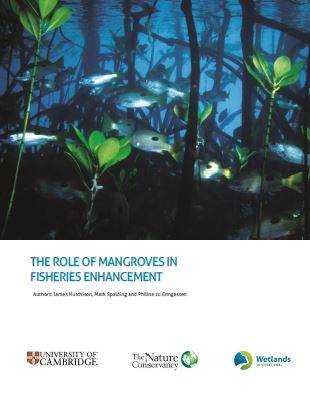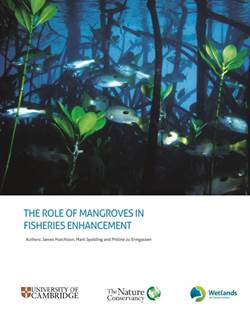
210 million people benefit from mangroves-associated fisheries
-
Aquaculture, fisheries and coastal agriculture
-
Coastal wetland conservation
Some 210 million people live in low elevation areas within 10 km of mangroves and many of these directly benefit from mangrove-associated fisheries. Yet, these people are often unaware of the key role mangroves may play, especially if the associated fisheries are offshore.

A new study by Wetlands International, The Nature Conservancy and the University of Cambridge, launched today at World Fisheries Day, concludes that mangrove conservation and restoration in areas close to human populations will render the greatest return on investment with respect to enhancing fisheries.
The fisheries value of mangroves is site specific as it depends on how many fish a mangrove produces, how many fish are subsequently caught by humans, and then what the fisheries value is, both in economic terms, as a food supply or through the livelihoods that they support.As demands for fish continues to rise with the increase of coastal populations and rapidly growing economies, understanding where mangrove-associated fish productivity is highest is critical. Well-known species that rely on mangroves in one way or another include crabs, prawns, mullet, herring, anchovy, snappers and groupers.
Fisheries value site specific
The values of fisheries, which can be stated in simple catch statistics, in monetary terms, as a food supply or through the livelihoods that they support, are site specific. The study concludes that fish populations that rely on mangroves will be highest where mangrove biomass productivity is highest, as leaves and woody materials form a key part of the marine food chains.
Fish productivity is also higher where there is high freshwater input from rivers and rainfall and where mangroves are in good condition. The total area of mangrove is clearly important in determining the total numbers of fish, but the length of the mangrove margin is also key, since generally it is the fringes of mangroves where fish populations are enhanced.
Root structure of the mangrove belt
Physical characteristics of mangroves, such as the dense tangle of aboveground roots, also enhance fisheries. Oysters grow on the roots, and theroots trap sediment thus creating soft soils ideal for molluscs and crustaceans to burrow in. The roots further provide shelter against predation. By providing food and shelter mangroves are perfect and safe nursery grounds for many species.
Safeguarding mangroves in densely populated areas
Fish catch will be highest close to areas of high human population density that provide the fishers and the markets for the catch. While these mangroves are generally under greater threat as a result of degradation, pollution and over-fishing, appropriate mangrove and fisheries management give the greatest value.
Dr Mark Spalding, senior marine scientist at The Nature Conservancy said: “We conclude that mangrove conservation and restoration efforts in areas close to human populations will likely give the greatest return on investment for enhancing fisheries”.
Dr. Femke Tonneijck, Wetlands International: “Many decision-makers and fishers are unaware of the key role mangrove forests may play in supporting fisheries, including offshore. We hope that the fuller understanding of this ecosystem service and its value in both social and economic terms will enhance the sustainable management of both mangroves and fisheries.”
For more information:
Wetlands International, [email protected]
The Nature Conservancy: [email protected]
Notes to editors:
1. The Nature Conservancy is a leading conservation organization working around the world to protect ecologically important lands and waters for nature and people. The Conservancy and its members have protected more than 480,000 sq km of land and is engaged in more than100 marine conservation projects in 24 countries, including the Caribbean and the Coral Triangle. The Conservancy is also developing policy and decision support tools for ecosystem-based adaptation and hazard reduction in the coastal zone.
2. Wetlands International works to safeguard and restore wetlands for people and nature. Wetlands International is an independent, non-profit organisation, active in around 100 countries and works through a network of many partners and experts to achieve its goals.

